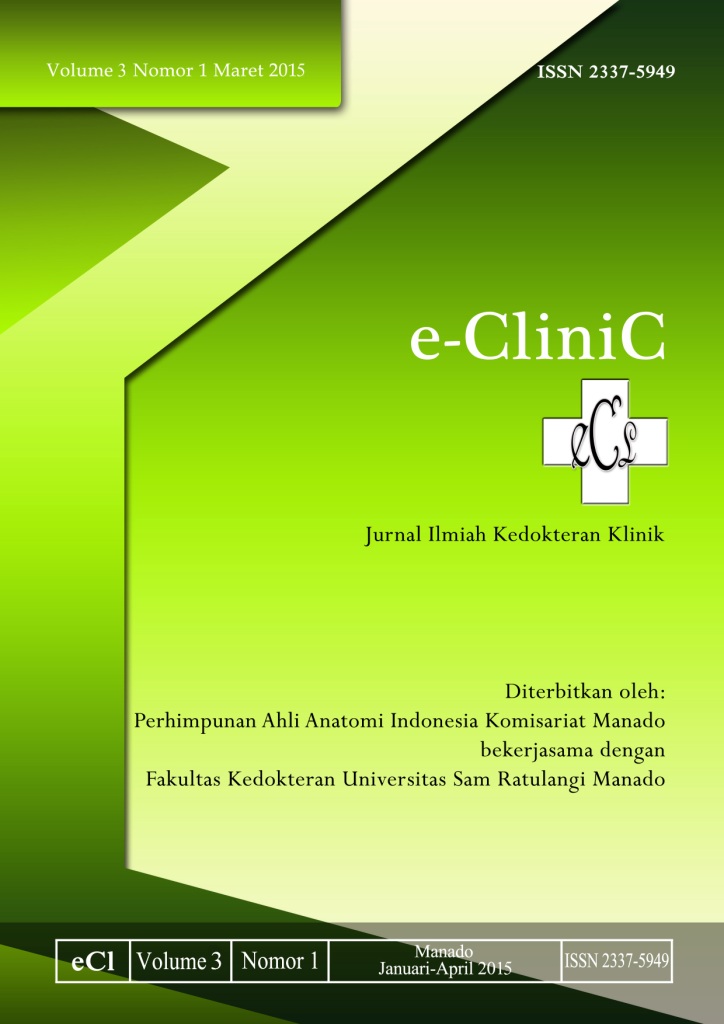PERBEDAAN TEKANAN DARAH PADA ANAK YANG TINGGAL DI PEGUNUNGAN DAN TINGGAL DI TEPI PANTAI
DOI:
https://doi.org/10.35790/ecl.v3i1.7403Abstract
Abstract: Blood pressure is the force that is necessary for blood to flow in blood vessels and circulation to all parts of the human body. The air pressure in the mountains is lower than at the beach, this causes increased erythrocyte production, which results in increased viscocity and resistance. This study aimed to determine the difference in blood pressure among children who live in the mountains and at the seaside. This was an observational survey with a cross sectional design. Samples taken to represent the two major populations were elementary students Wulurmaatus Modoinding, South Minahasa (mountain area) and elementary students Inpres 12/79 Wangurer, Madidir Bitung (beach area). In the target population sampling is done by simple random sampling and at affordable population sampling conducted consecutive sampling. Found as many as 28 boys in the mountains and 24 boys on the beach with an average TDS respectively 90.3 mmHg and 94.1 mmHg (Ï = 0.126) and the average TDD respectively 62, 1 mmHg and 64.7 mmHg (Ï = 0.146). And as many as 25 girls in the mountains and 28 girls on the beach with an average TDS respectively 88.7 mmHg and 93.5 mmHg (Ï = 0.065) and the average TDD found respectively 63.7 mmHg and 66 mmHg (Ï = 0.139). From the results obtained it can be concluded that there was no difference in blood pressure (systolic and diastolic) in children who live in the mountains and at the seaside.
Keywords: blood pressure, children, mountains, beach front
Abstrak: Tekanan darah merupakan kekuatan yang diperlukan agar darah dapat mengalir di dalam pembuluh darah dan beredar ke seluruh bagian tubuh manusia. Tekanan udara di pegunungan lebih rendah di bandingkan di tepi pantai; hal ini meningkatkan produksi eritrosit, yang mengakibatkan peningkatan viskositas serta resistensi, Penelitian ini bertujuan untuk mengetahui perbedaan tekanan darah pada anak yang tinggal di pegunungan dan di tepi pantai. Penelitian ini bersifat survei observasional dengan rancangan potong lintang. Sampel diambil mewakili ke dua populasi, yaitu siswa SD Inpres Wulurmaatus Kecamatan Modoinding, Kabupaten Minahasa Selatan (pegunungan) dan siswa SD Inpres 12/79 Wangurer, Kecamatan Madidir Kota Bitung (tepi pantai). Pada populasi target pengambilan sampel dilakukan secara simple random sampling dan pada populasi terjangkau pengambilan sampel dilakukan secara consecutive sampling. Ditemukan sebanyak 28 anak laki-laki di pegunungan dan 24 anak laki-laki di tepi pantai dengan rata-rata TDS masing-masing 90,3 mmHg dan 94,1 mmHg (Ï=0,126) serta rata-rata TDD masing-masing 62,1 mmHg dan 64,7 mmHg (Ï=0,146). Sebanyak 25 anak perempuan di pegunungan dan 28 anak perempuan di tepi pantai dengan rata-rata TDS masing-masing 88,7 mmHg dan 93,5 mmHg (Ï=0,065) serta rata-rata TDD ditemukan masing-masing 63,7 mmHg dan 66 mmHg (Ï= 0,139). Simpulan: Tidak terdapat perbedaan tekanan darah (sistolik dan diastolik) pada anak yang yang tinggal di pegunungan dan di tepi pantai.
Kata kunci: tekanan darah, anak, pegunungan, tepi pantai
Downloads
How to Cite
Issue
Section
License
COPYRIGHT
Authors who publish with this journal agree to the following terms:
Authors hold their copyright and grant this journal the privilege of first publication, with the work simultaneously licensed under a Creative Commons Attribution License that permits others to impart the work with an acknowledgment of the work's origin and initial publication by this journal.
Authors can enter into separate or additional contractual arrangements for the non-exclusive distribution of the journal's published version of the work (for example, post it to an institutional repository or publish it in a book), with an acknowledgment of its underlying publication in this journal.
Authors are permitted and encouraged to post their work online (for example, in institutional repositories or on their website) as it can lead to productive exchanges, as well as earlier and greater citation of the published work (See The Effect of Open Access).







